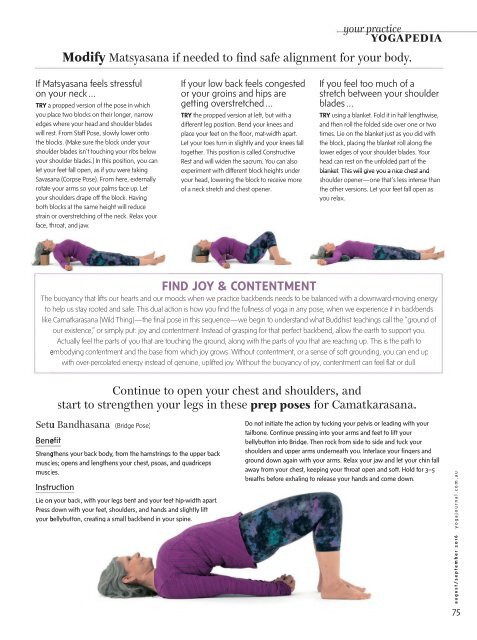Australian_Yoga_Journal_2016_08_09_downmagaz.com
Create successful ePaper yourself
Turn your PDF publications into a flip-book with our unique Google optimized e-Paper software.
your practice<br />
YOGAPEDIA<br />
Modify Matsyasana if needed to find safe alignment for your body.<br />
If Matsyasana feels stressful<br />
on your neck ...<br />
TRY a propped version of the pose in which<br />
you place two blocks on their longer, narrow<br />
edges where your head and shoulder blades<br />
will rest. From Staff Pose, slowly lower onto<br />
the blocks. (Make sure the block under your<br />
shoulder blades isn’t touching your ribs below<br />
your shoulder blades.) In this position, you can<br />
let your feet fall open, as if you were taking<br />
Savasana (Corpse Pose). From here, externally<br />
rotate your arms so your palms face up. Let<br />
your shoulders drape off the block. Having<br />
If your low back feels congested<br />
or your groins and hips are<br />
getting overstretched ...<br />
TRY the propped version at left, but with a<br />
different leg position. Bend your knees and<br />
place your feet on the floor, mat-width apart.<br />
Let your toes turn in slightly and your knees fall<br />
together. This position is called Constructive<br />
Rest and will widen the sacrum. You can also<br />
experiment with different block heights under<br />
your head, lowering the block to receive more<br />
of a neck stretch and chest opener.<br />
If you feel too much of a<br />
stretch between your shoulder<br />
blades ...<br />
TRY using a blanket. Fold it in half lengthwise,<br />
and then roll the folded side over one or two<br />
times. Lie on the blanket just as you did with<br />
the block, placing the blanket roll along the<br />
lower edges of your shoulder blades. Your<br />
head can rest on the unfolded part of the<br />
blanket This will give you a nice chest and<br />
FIND JOY & CONTENTMENT<br />
The buoyancy that lifts our hearts and our moods when we practice backbends needs to be balanced with a downward-moving energy<br />
to help us stay rooted and safe. This dual action is how you find the fullness of yoga in any pose; when we experience it in backbends<br />
like Camatkarasana (Wild Thing)—the final pose in this sequence—we begin to understand what Buddhist teachings call the “ground of<br />
our existence,” or simply put: joy and contentment. Instead of grasping for that perfect backbend, allow the earth to support you.<br />
Actually feel the parts of you that are touching the ground, along with the parts of you that are reaching up. This is the path to<br />
e<br />
Setu<br />
Bene<br />
Streng<br />
musc<br />
musc<br />
Instr<br />
Lie on<br />
Press<br />
your b<br />
august/september <strong>2016</strong> yogajournal.<strong>com</strong>.au<br />
75


